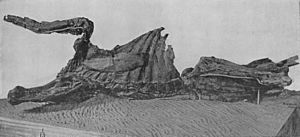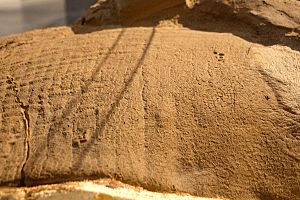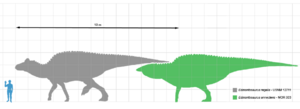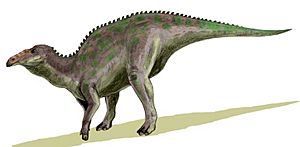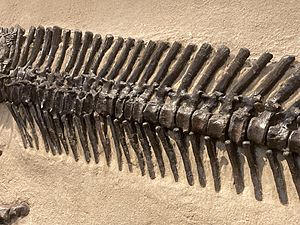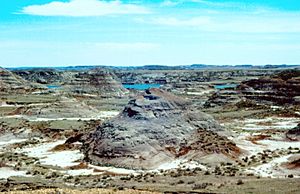Edmontosaurus annectens facts for kids
Quick facts for kids Edmontosaurus annectens |
|
|---|---|
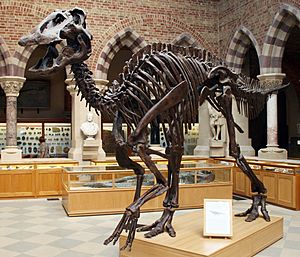 |
|
| Mounted cast of a fossil E. annectens skeleton, Oxford University Museum of Natural History | |
| Scientific classification | |
| Genus: |
Edmontosaurus
|
| Species: |
annectens
|
| Synonyms | |
|
|
Edmontosaurus annectens (meaning "connected lizard from Edmonton") was a large, plant-eating dinosaur with a flat head and a wide, duck-like beak. It lived at the very end of the Cretaceous period, about 68 to 66 million years ago. This was just before the big event that caused the extinction of the dinosaurs.
Fossils of E. annectens have been found in western North America. These include areas in the U.S. states of Montana, South Dakota, North Dakota, Wyoming, and Colorado, as well as the Canadian province of Saskatchewan. This dinosaur was quite big, growing up to about 12 meters (39 feet) long. It could weigh around 5.6 metric tons (6.2 short tons), which is like a large elephant!
E. annectens is famous for its "duckbill" snout. Over the years, its fossils were given many different names, like Anatosaurus (meaning "duck lizard") and Anatotitan. But now, scientists agree that all these fossils belong to the same group, Edmontosaurus.
Contents
Discovering the Duck-Billed Dinosaur
The story of Edmontosaurus annectens is a bit complicated because its fossils were given many different names over time. Scientists often changed their minds about which group these dinosaurs belonged to.
Early Finds and Confusing Names
The first important fossil, a complete skull and most of a skeleton, was found in 1882. It was discovered in South Dakota by Dr. J. L. Wortman and R. S. Hill. This fossil even had detailed skin impressions!
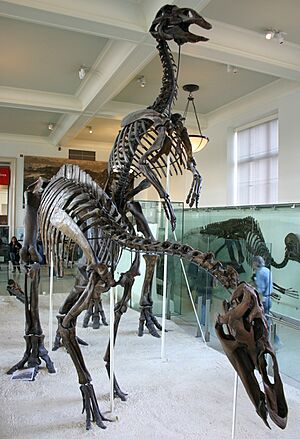
A famous paleontologist named Edward Drinker Cope studied this fossil. He thought it was a new species and named it Diclonius mirabilis. Cope believed these dinosaurs lived in water, like amphibians. He thought their teeth and beaks were too weak for eating tough land plants. However, he was mistaken about the strength of their jaws.
Another important fossil, a large lower jaw, was found in 1889 by John Bell Hatcher in Wyoming. Othniel Charles Marsh, another famous paleontologist, named this jaw Trachodon longiceps. It was much bigger than the jaw from Cope's specimen.
In 1904, a nearly complete skeleton was found in Montana by a rancher. This fossil was later bought and excavated by Barnum Brown. In 1908, Cope's and Brown's skeletons were put on display together at the American Museum of Natural History in New York. They were shown as Trachodon mirabilis. One was posed on all fours, as if eating, and the other standing up, as if startled.
Marsh Names Claosaurus annectens
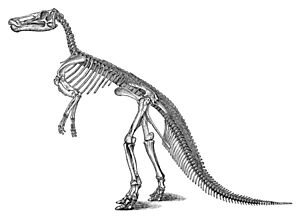
The species we now call Edmontosaurus annectens was officially named in 1892 by Othniel Charles Marsh. He called it Claosaurus annectens. This name came from a partial skull and skeleton found in Wyoming.
These fossils are very important in history. One of them, YPM 2182, was the first nearly complete dinosaur skeleton ever put on display in the United States in 1901. Another, USNM 2414, was displayed in 1904.
In the early 1900s, two more amazing fossils were found. One, nicknamed the "Trachodon mummy" (AMNH 5060), was discovered in 1908 by Charles Hazelius Sternberg and his sons. This fossil was incredibly well-preserved, even showing skin impressions! Another similar fossil with skin impressions was found in 1910.
Canadian Discoveries
The name Edmontosaurus itself was created in 1917 by Lawrence Lambe. He used it for two partial skeletons found in Alberta, Canada. These fossils came from older rock layers than where Claosaurus annectens was found.
In 1926, Charles Mortram Sternberg named Thespesius saskatchewanensis for a skull and partial skeleton found in Saskatchewan, Canada. This was the first major dinosaur fossil found in that area.
The Anatosaurus Name and Beyond
Because there were so many different names for similar duck-billed dinosaurs, it became very confusing. In 1942, scientists Richard Swann Lull and Nelda Wright tried to clear things up. They created a new name, Anatosaurus, which means "duck lizard." They put many of the confusing fossils, including Marsh's Claosaurus annectens, into this new group. They even gave a new species name, Anatosaurus copei, to Cope's original fossil. For a long time, Anatosaurus was known as the "classic duck-billed dinosaur."
However, in the 1970s and 1980s, a scientist named Michael K. Brett-Surman studied these fossils again. He realized that Anatosaurus annectens was actually a type of Edmontosaurus. He also thought that Anatosaurus copei was different enough to be its own group, which he called Anatotitan.
Because Anatosaurus annectens was moved to Edmontosaurus, the name Anatosaurus was no longer used. Today, most scientists agree that Anatotitan copei is actually just an Edmontosaurus annectens whose skull was flattened or changed as it grew older. This means that Edmontosaurus annectens is the correct name for all these fossils.
In 2007, another amazing "mummy" fossil, nicknamed "Dakota", was found in North Dakota. It also had incredible skin impressions.
What Edmontosaurus annectens Looked Like
We know a lot about the skull and skeleton of Edmontosaurus annectens. It was a very long dinosaur. Early estimates suggested it could be up to 12 meters (39 feet) long. Some very large fossils suggest it might have reached nearly 15 meters (49 feet) and weighed 10 metric tons (11 short tons), but these giant individuals were probably rare. A recent study suggests that a fully grown adult was typically 11 to 12 meters (36 to 39 feet) long and weighed about 5.6 metric tons (6.2 short tons).
The skull of E. annectens was very long and wide, especially its muzzle. It looked a bit like a goose or a spoonbill. This long, flat shape became even more noticeable as the dinosaur grew older. Young Edmontosaurus had shorter, less extreme snouts.
The bones around its nostrils formed deep pockets. These might have held inflatable soft-tissue sacs, like balloons, that the dinosaur could use to make sounds or show off.
Like other duck-billed dinosaurs, E. annectens had a strong beak at the front of its mouth. This beak was covered by a horn-like sheath, which helped it crop plants. Inside its mouth, it had hundreds of teeth packed together in "dental batteries." These teeth were constantly replaced, allowing the dinosaur to grind tough plant material like a chewing machine.
E. annectens could walk on both two legs (bipedally) and four legs (quadrupedally). It probably walked on all fours when looking for food, but could run on two legs if it needed to escape danger.
How Edmontosaurus Grew
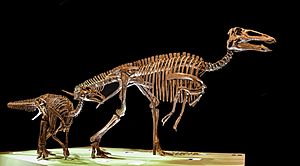
Scientists have studied many Edmontosaurus skulls to understand how they changed as the dinosaurs grew. They found that many features, like the shape of the skull, changed a lot from when they were young to when they were fully grown.
This explains why scientists used to think there were different species. What was once called E. saskatchewanensis was likely a young Edmontosaurus annectens. What was called Anatotitan copei was probably a fully mature adult E. annectens with a very long, flat skull. Studies suggest that E. annectens reached its full size in about 9 years.
Where Edmontosaurus Lived

Edmontosaurus annectens lived in North America during the very last part of the Cretaceous period. Its fossils are found in rock layers like the Hell Creek Formation and Lance Formation.
This time was the very end of the dinosaur age. Edmontosaurus was one of the most common dinosaurs, often found alongside the horned dinosaur Triceratops. These two dinosaurs made up most of the large dinosaur population in their area.
The areas where Edmontosaurus lived were mostly flat, forested floodplains. The climate was warm and humid, like a subtropical region. Many different plants grew there, including flowering plants, conifers (like bald cypress), ferns, and ginkgos.
Other dinosaurs living with Edmontosaurus annectens included the small plant-eater Thescelosaurus, the armored Ankylosaurus, and fierce meat-eaters like Tyrannosaurus. Some Edmontosaurus fossils even show bite marks that might have come from a Tyrannosaurus!
Images for kids
-
E. annectens paratype YPM 2182 at the Yale University Museum, the first nearly complete dinosaur skeleton mounted in the United States.
-
Outdated 1909 life restoration of Trachodon by Charles R. Knight, based on the two specimens (now classified as E. annectens) mounted in 1908 at the AMNH, New York.
-
E. annectens holotype, Smithsonian National Museum of Natural History.
See also
 In Spanish: Anatosaurus para niños
In Spanish: Anatosaurus para niños
- Timeline of hadrosaur research


